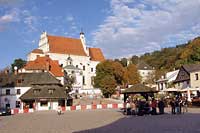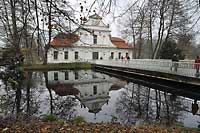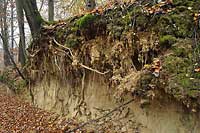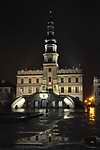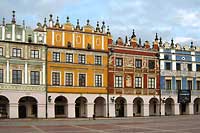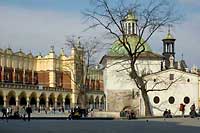SOUTH-EAST POLAND - FAR FROM THE MADDING CROWD

This route leads through areas of high biological diversity - from the Vistula river valley, through the swamps and peat-bogs of Polesie, across the limestone upland of Roztocze to an extensive complex of fishponds. Two national parks, several landscape parks and numerous nature reserves protect an abundance of wildlife as well as picturesque countryside. The flora and fauna contains a high incidence of South European species, which cannot be found elsewhere in Poland. The whole area is relatively remote and little visited and provides an opportunity for close contact with nature.
ITINERARY

DAY ONE
Assemble in Warsaw and transfer by coach to Kazimierz [150 km]. We travel along the most important stretch of the Vistula, where its flow and course is unregulated. Numerous sandy islets, old river-beds and wet scrub are home for about 50 waterfowl species, such as: Corncrake Crex crex, Little Ringed Plover Charadrius dubius, Ringed Plover Ch. hiaticula, Black-tailed Godwit Limosa limosa, Redshank Tringa totanus, Common Sandpiper Actitis hypoleucos, Herring Gull Larus argentatus, Little Tern Sterna albifrons, Kingfisher Alcedo atthis, Bluethroat Luscinia svecica and Oystercatcher Haematopus astralegus.
Overnight stay in Kazimierz.
DAY TWO
After a morning birdwatching on the Vistula in the immediate environs of Kazimierz, we travel to Urszulin with stops at important sites for birds in the meadows of the Wieprz river valley or at the peatbogs of the Usciwierz and Sumin lakes.
Overnight stay in Urszulin, close to Poleski National Park.
DAY THREE
A full day visit to the north part of the Poleski National Park. It is a land of vegetating lakes, peatbogs and wet forests where about 150 species of birds nest, amongst them: Little Grebe Tachybaptus ruficollis, Red-necked Grebe Podiceps griseigena, Black Stork Ciconia nigra, Greylag Goose Anser anser, Black Kite Milvus migrans Marsh Harrier Circus aeruginosus, Montagu's Harrier C. pygargus, Lesser Spotted Eagle Aquila pomarina, Black Grouse Tetrao tetrix, Water Rail Rallus aquaticus, Little Crake Porzana parva, Corncrake Crex crex, Crane Grus grus, Ruff Philomachus pugnax, Black-tailed Godwit Limosa limosa, Curlew Numenius arquata, Green Sandpiper Tringa ochropus, Eagle Owl Bubo bubo, Long-eared Owl Asio otus, Short-eared Owl Asio flammeus, Green Woodpecker Picus viridis, Bluethroat Luscinia svecica, Savi's Warbler Locustella luscinioides, River Warbler L. fluviatilis, Grasshopper Warbler L. naevia, Aquatic Warbler Acrocephalus paludicola, Penduline Tit Remiz pendulinus and Lesser Grey Shrike Lanius minor.
Overnight stay in Urszulin.
DAY FOUR
We start with a visit to the southern part of Poleski National Park, where there are vast, partly cultivated marshes. Birds nesting here include: Montagu's Harrier Circus pygargus, Kestrel Falco tinnunculus, Black Grouse Tetrao tetrix, Spotted Crake Porzana porzana, Corncrake Crex crex, Great Snipe Gallinago media, Black-tailed Godwit Limosa limosa, Curlew Numenius arquata, Short-eared Owl Asio flammeus, Savi's Warbler Locustella luscinioides, Penduline Tit Remiz pendulinus, Common Rosefinch Carpodacus erythrinus and Aquatic Warbler Acrocephalus paludicola.
Later we continue south to an area of carbonate peatbogs, protected by the Chelmski Landscape Park. It is a land characterised by a mosaic system of biotopes, famous for rare plants, but it is also interesting for birdwatchers. Amongst birds here are: Bittern Botaurus stellaris, Garganey Anas querguedula, Marsh Harrier Circus aeruginosus, Hobby Falco subbuteo, Spotted Crake Porzana porzana, Lapwing Vanellus vanellus, Short-eared Owl Asio flammeus, Great Snipe Gallinago media, Bluethroat Luscinia svecica, Aquatic Warbler Acrocephalus paludicola and Common Rosefinch Carpodacus erythrinus.
Overnight stay in Chelm or Hrubieszow.
DAY FIVE
We explore wet meadows which stretch 30 kilometres along the Bug river. This area, together with neighbouring forests, is protected as a landscape park. Beyond the Bug, vast wetlands extend far into Ukraine.
Birds nesting in the Bug river valley include: Bittern Botaurus stellaris, Marsh Harrier Circus aeruginosus, Montagu's Harrier Circus pygargus, Corncrake Crex crex, Little Ringed Plover Charadrius dubius, Black-tailed Godwit Limosa limosa, Common Sandpiper Actitis hypoleucos, Kingfisher Alcedo atthis, River Warbler Locustella fluviatilis and Common Rosefinch Carpodacus erythrinus. From the surrounding forests Black Stork Ciconia nigra and Lesser Spotted Eagle Aquila pomarina come here to feed. In the afternoon we travel via Zamosc to Roztocze National Park [100 km]. The park consists of valuable ancient forests, so amongst approximately 130 species of nesting birds are many typical forest species, such as: eight woodpeckers - Green W. Picus viridis, Grey-headed W. P. canus, Great Spotted W. Dendrocopos major, Middle-spotted W. D. medius, Lesser Spotted W. D. minor, White-backed W. D. leucotos, Black W. Dryocopus martius and Wryneck Jynx torquilla; Capercaille Tetrao urogallus, Black Stork Ciconia nigra, Spotted Flycatcher Musciapa striata, Collared Flycatcher Ficedula albicollis, Pied Flycatcher F. hypoleuca, Red-breasted Flycatcher F. parva, Hawfinch Coccothraustes coccothraustes, Golden Oriole Oriolus oriolus and Roller Coracias garrulus.
Overnight stay in Zwierzyniec, a small town surrounded by forests.
DAY SIX
After a morning visit to the National Park we travel west, towards Janow Lubelski, to a vast forest complex. Its western part, with numerous ponds surrounded by trees, is protected as a landscape park. It is an important sanctuary for waterfowl as well as forest birds. Nesting birds include: Bittern Botaurus stellaris, Black Stork Ciconia nigra, Ferruginous Duck Aythya nyroca, Honey Buzzard Pernis apivorus, Black Kite Milvus migrans, Red Kite M. milvus, Short-toed Eagle Circaetus gallicus, White-tailed Eagle Haliaetus albicilla, Lesser Spotted Eagle Aquila pomarina, Hazelhen Tetrastes bonasia, Black Grouse Tetrao tetrix, Capercaille Tetrao urogallus, Spotted Crake Porzana porzana, Little Crake P. parva, Corncrake Crex crex, Crane Grus grus, Nightjar Caprimulgus europaeus, Great Grey Shrike Lanius excubitor, Grey-Headed Woodpecker Picus canus and White-backed Woodpecker Dendrocopos leucotos.
The forest is also home for big mammals such as Red Deer, Elk, Wild Boar, and Wolf. In dry and sun-warmed places you are likely to encounter the Mantis Mantis religiosa.
Overnight stay in Janow Lubelski.
DAY SEVEN
We continue birdwatching in Janow Forest then travel west toward Tarnobrzeg [40 km] to an extensive fishpond complex. Tens of kilometres of dykes which divide the ponds provide a perfect opportunity for birdwatching walks. Over 200 species of birds have been recorded there. Amongst those which nest are: Little Grebe Tachybaptus ruficollis, Black-necked Grebe Podiceps nigricollis, Great Crested Grebe P. cristatus, Black Stork Ciconia nigra, White Stork C. ciconia, Grey Heron Ardea cinerea, Purple Heron A. purpurea, Bittern Botaurus stellaris, Little bittern Ixobrychus minutus, White-tailed Eagle Haliaetus albicilla, Honey Buzzard Pernis apivorus, Marsh Harrier Circus aeruginosus, Montagu's Harrier C. pygargus, Greylag Goose Anser anser, Gadwall Anas strepera, Shoveler A. clypeata, Corncrake Crex crex, Black Tern Chlidonias niger, Kingfisher Alcedo atthis, Hoopoe Upupa epops, Savi's Warbler Locustella luscinioides, Grasshopper Warbler Locustella naevia, Bluethroat Luscinia svecica, Bearded Tit Panurus biarmicus, Barred Warbler Sylvia nisoria, Red-backed Shrike Lanius collurio and Great Grey Shrike Lanius excubitor.
In the evening we transfer to Cracow [160 km] for an overnight stay.
DAY EIGHT
Farewell and departure from Cracow.
OPTIONAL VISITS
During this tour optional visits can be arranged to the following important historical monuments:- Warsaw - the biggest city and capital of Poland, totally destroyed during the Second World War. The old town, carefully reconstructed after the War, has been recognised as a World Heritage Site
- Kazimierz Dolny - the picturesque old town known as 'A Pearl of the Renaissance'
- Lublin - an old city centre and an interesting castle chapel with well preserved Byzantine frescoes
- The former Nazi death camp at Majdanek where 360000 people were murdered
- Zamosc - an outstanding monument of Renaissance town planning and architecture, a World Heritage Site
- The magnificent baroque palace at Baranow Sandomierski
- Cracow - one thousand years old and for many of them Poland's capital city; a centre of culture and science with the Jagiellonian University founded in 1364, and a World Heritage Site
- Wieliczka [near Cracow] - the medieval but still working salt mines with its vast underground maze of unique chambers and passages, also a World Heritage Site










